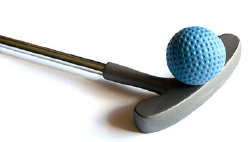Tennis and golf players
This problem solving activity has a number focus.

In fact 80% play tennis and 70% play golf.
What percentage play both games?
- Find a percentage of a given quantity.
- Perform calculations using basic percentages.
- Find lowest common multiples (extension).
- Use Venn diagrams to represent intersecting sets.
- Devise and use problem solving strategies (draw a diagram).
This problem involves reasoning with percentages. Percentages are fractions that are used to express the whole divided into one hundred equal parts. One percent means one-hundredth part of a whole or unit (e.g. 1/100), and the notation used is 1%. In the extension to this problem the students need to find the lowest common multiples of the numbers 20, 30 and 50. Your students should have some knowledge of percentages to successfully work with this problem.
One approach to this problem is to draw a diagram, representing the problem with intersecting sets. As Venn diagrams are sometimes difficult for students to understand it can be helpful to build them one step at a time, with several examples being explored at each step.
- Identify a subset e.g. blue shapes from all coloured shapes.
- Build and explore 2 non-intersecting sets, e.g. triangles and circles
- Build and explore intersecting sets, e.g. triangles and shapes with a right angle.
The Problem
In a class in the school down the road, everyone plays tennis or golf or both. In fact 80% play tennis and 70% play golf. What percentage play both games?
Teaching Sequence
- Introduce the problem to the class. It could be posed as a puzzle with 3 given clues.
- Brainstorm ways to solve the problem. The easiest way to solve this problem is to draw a diagram. Check that the students understand that in the problem students can play both golf and tennis.
- Circulate as the students work taking the opportunity for the students to share their understanding of percentages and their use of diagrams.
What does 80% of the class mean?
What does 70% of the class mean?
How do you know what percentage play both tennis and golf?
How do you know what percentage of the class do not play each sport?
How has your diagram helped you to solve the problem?
What information did you need to include in your diagram? - Share solutions.
Extension
What is the smallest number of students in that class?
Solution
If 80% of the class plays tennis, 20% don’t play tennis. This 20% must be part of the golf players (they play golf only). Similarly, if 70% of the class plays golf, 30% don’t play golf. This 30% must be part of the tennis players (they play tennis only). This means that the remaining 50% play both tennis and golf.
Solution to the Extension
Find the smallest number so that the various percentages of the Venn Diagram are whole numbers. 20%, 30% and 50% of the class need to be whole numbers. This will be the case if 20, 30 and 50 are in each group. It is also the case with 10, 15 and 25. So how do we get the smallest class?
What is the biggest number that goes into 20, 30 and 50. Once we’ve found that, if we divide 20, 30 and 50 by that amount we will have the smallest numbers we want. This biggest divisor is 10. So the separate amounts are 2, 3 and 5. The class has only 10 students.
